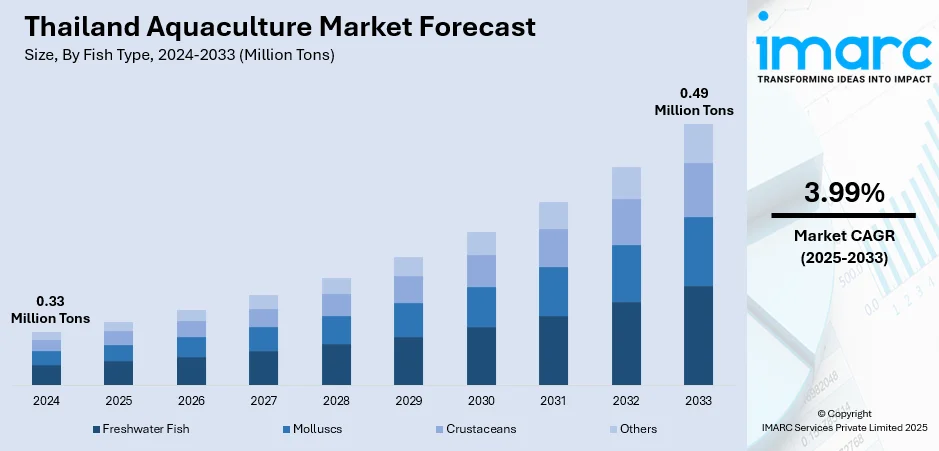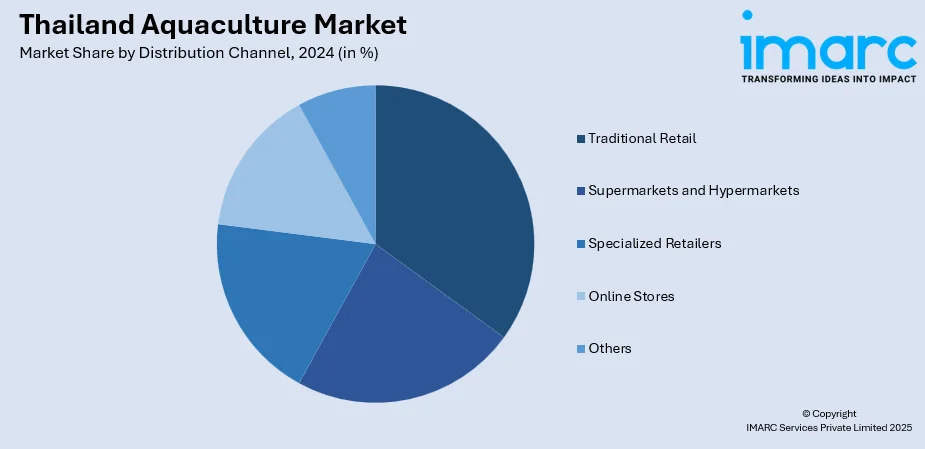
Thailand Aquaculture Market Size, Share, Trends and Forecast by Fish Type, Environment, Distribution Channel, and Region, 2025-2033
Thailand Aquaculture Market Overview:
The Thailand aquaculture market size reached 0.33 Million Tons in 2024. Looking forward, the market is projected to reach 0.49 Million Tons by 2033, exhibiting a growth rate (CAGR) of 3.99% during 2025-2033. The country’s aquaculture sector thrives on extensive seafood export infrastructure, supportive government policies, and a strong rural workforce. Innovation in shrimp farming techniques and mangrove-integrated systems also boosts sustainability. Together, these factors fuel Thailand aquaculture market share growth and reinforce its global competitiveness.
|
Report Attribute
|
Key Statistics
|
|---|---|
|
Base Year
|
2024
|
|
Forecast Years
|
2025-2033
|
|
Historical Years
|
2019-2024
|
| Market Size in 2024 | 0.33 Million Tons |
| Market Forecast in 2033 | 0.49 Million Tons |
| Market Growth Rate 2025-2033 | 3.99% |
Thailand Aquaculture Market Trends:
Expansion of Sustainable Farming
Thailand increasingly adopts integrated mangrove‑shrimp aquaculture (IMS), combining shrimp ponds with mangrove plantings to restore ecological balance while enhancing yield. This approach addresses mangrove deforestation, improves water quality, and stabilizes shrimp production, offering both environmental and economic benefits. As inland and coastal communities seek sustainable livelihoods, IMS systems become vital, particularly when mangrove coverage between 30%–50% is optimal for profitability. This trend underscores Thailand aquaculture market growth, driven by the need for resilient, climate‑aligned farming systems that align with global sustainability standards. For instance, at the 2025 UN Ocean Conference, Thai Union launched new commitments under its SeaChange 2030 strategy, pledging to invest $200 Million by 2030 to improve aquaculture sustainability, traceability, and emissions reduction. Initiatives include the Lower Carbon Shrimp Programme and efforts to protect marine ecosystems. Thai Union aims to decarbonize shrimp production, reduce Scope 3 emissions, and eliminate bycatch risks. The company also reported a 21% drop in Scope 1 and 2 emissions and removal of 234 tonnes of plastic from oceans.

To get more information on this market, Request Sample
Technological Integration in Precision Aquaculture
The adoption of IoT-enabled systems and sensor networks in Thailand has begun transforming aquaculture. Real-time water quality monitoring, automated feeding, and smart biomarkers facilitate prompt decision-making, reducing wastage and disease risks. These technologies enhance yield efficiency and streamline operations, particularly for shrimp and freshwater fish. As farmers prioritize precision and productivity, digital tools are becoming essential. The rise of precision aquaculture marks a shift in traditional practices toward data-driven farming methods, boosting Thailand aquaculture market growth through improved cost‑effectiveness and system resilience. For instance, Thailand will host the 14th Aquaculture Roundtable Series (TARS) 2025 in Chiang Mai in August, focusing on precision shrimp aquaculture. The event will address low shrimp prices, disease outbreaks, and unsustainable farming models. It will also feature interactive sessions on genetics, nutrition, processing, and youth involvement to future-proof the shrimp sector.
Thailand Aquaculture Market Segmentation:
IMARC Group provides an analysis of the key trends in each segment of the market, along with forecasts at the region/country level for 2025-2033. Our report has categorized the market based on fish type, environment, and distribution channel.
Fish Type Insights:
- Freshwater Fish
- Molluscs
- Crustaceans
- Others
The report has provided a detailed breakup and analysis of the market based on the fish type. This includes freshwater fish, molluscs, crustaceans, and others.
Environment Insights:
- Fresh Water
- Marine Water
- Brackish Water
A detailed breakup and analysis of the market based on the environment have also been provided in the report. This includes fresh water, marine water, and brackish water.
Distribution Channel Insights:

- Traditional Retail
- Supermarkets and Hypermarkets
- Specialized Retailers
- Online Stores
- Others
The report has provided a detailed breakup and analysis of the market based on the distribution channel. This includes traditional retail, supermarkets and hypermarkets, specialized retailers, online stores, and others.
Regional Insights:
- Bangkok
- Eastern
- Northeastern
- Southern
- Northern
- Others
The report has also provided a comprehensive analysis of all the major regional markets, which include Bangkok, Eastern, Northeastern, Southern, Northern, and others.
Competitive Landscape:
The market research report has also provided a comprehensive analysis of the competitive landscape. Competitive analysis such as market structure, key player positioning, top winning strategies, competitive dashboard, and company evaluation quadrant has been covered in the report. Also, detailed profiles of all major companies have been provided.
Thailand Aquaculture Market News:
- In June 2025, Thai Union Feedmill (TFM) invested over 300 million baht in 2025 to upgrade its aquafeed production lines to Industry 4.0 standards, covering 60% of its capacity. This move supports rising demand for shrimp and seabass feed, which saw strong sales growth in April–May 2025. TFM focuses on sustainable, high-quality feed and has expanded its customer base.
- In May 2025, ADB and Thai Union signed a $150 Million blue loan, the first for Thailand's agribusiness sector, to enhance sustainable shrimp farming. The package includes $50 Million from ADB and $100 Million syndicated from six banks. It supports shrimp farmers through training, certification, and R&D while promoting resilience against disease and climate impacts. This deal aligns with Thai Union's sustainability roadmap and reflects growing blue finance investment aimed at preserving aquatic ecosystems and boosting the sustainability of seafood supply chains.
Thailand Aquaculture Market Report Coverage:
| Report Features | Details |
|---|---|
| Base Year of the Analysis | 2024 |
| Historical Period | 2019-2024 |
| Forecast Period | 2025-2033 |
| Units | Million Tons |
| Scope of the Report |
Exploration of Historical Trends and Market Outlook, Industry Catalysts and Challenges, Segment-Wise Historical and Future Market Assessment:
|
| Fish Types Covered | Freshwater Fish, Molluscs, Crustaceans, Others |
| Environments Covered | Fresh Water, Marine Water, Brackish Water |
| Distribution Channels Covered | Traditional Retail, Supermarkets and Hypermarkets, Specialized Retailers, Online Stores, Others |
| Regions Covered | Bangkok, Eastern, Northeastern, Southern, Northern, Others |
| Customization Scope | 10% Free Customization |
| Post-Sale Analyst Support | 10-12 Weeks |
| Delivery Format | PDF and Excel through Email (We can also provide the editable version of the report in PPT/Word format on special request) |
Key Questions Answered in This Report:
- How has the Thailand aquaculture market performed so far and how will it perform in the coming years?
- What is the breakup of the Thailand aquaculture market on the basis of fish type?
- What is the breakup of the Thailand aquaculture market on the basis of environment?
- What is the breakup of the Thailand aquaculture market on the basis of distribution channel?
- What is the breakup of the Thailand aquaculture market on the basis of region?
- What are the various stages in the value chain of the Thailand aquaculture market?
- What are the key driving factors and challenges in the Thailand aquaculture market?
- What is the structure of the Thailand aquaculture market and who are the key players?
- What is the degree of competition in the Thailand aquaculture market?
Key Benefits for Stakeholders:
- IMARC’s industry report offers a comprehensive quantitative analysis of various market segments, historical and current market trends, market forecasts, and dynamics of the Thailand aquaculture market from 2019-2033.
- The research report provides the latest information on the market drivers, challenges, and opportunities in the Thailand aquaculture market.
- Porter's five forces analysis assist stakeholders in assessing the impact of new entrants, competitive rivalry, supplier power, buyer power, and the threat of substitution. It helps stakeholders to analyze the level of competition within the Thailand aquaculture industry and its attractiveness.
- Competitive landscape allows stakeholders to understand their competitive environment and provides an insight into the current positions of key players in the market.
Need more help?
- Speak to our experienced analysts for insights on the current market scenarios.
- Include additional segments and countries to customize the report as per your requirement.
- Gain an unparalleled competitive advantage in your domain by understanding how to utilize the report and positively impacting your operations and revenue.
- For further assistance, please connect with our analysts.
 Request Customization
Request Customization
 Speak to an Analyst
Speak to an Analyst
 Request Brochure
Request Brochure
 Inquire Before Buying
Inquire Before Buying




.webp)




.webp)












